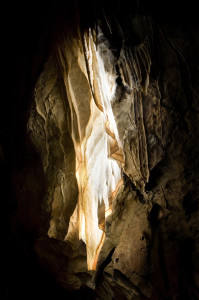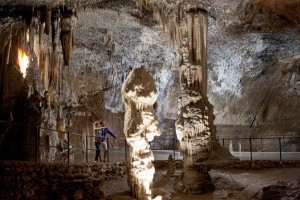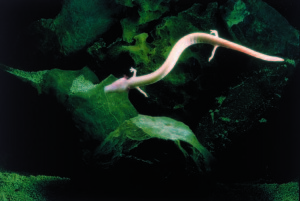THE QUEEN OF CAVES – AND HER BABY DRAGONS
Here be dragons – baby dragons. Or so people thought 100s of years ago when they first discovered the white salamanders that live in Postojna Cave in Slovenia. These blind creatures, with pale skin that looks like human flesh (hence their other name – human fish) live their entire lives in the darkness of the cave. They feed on a small translucent shrimps (and almost anything else they chance upon that’s been washed into the cave) and spend most of their life underwater – despite being amphibian.
Their correct name is Proteus anguinus and they can only be found in a small area of eastern Europe running along the coast from Croatia, through Slovenia to the north of Italy. They live exclusively in the karst caves of the region and never venture into the light. In the past they could be found in around 30 caves but now that number has dwindled to just three – thanks to human pollution and disturbance.
They are one of the reasons the Postojna Cave attracts over 600,000 tourists per year – but they are not the only reason. This cave is called the Queen of Caves – and it’s a title it deserves. 21km of tunnels and chambers weave their way underground packed, like an overstuffed art gallery, with stunning natural rock features created over hundreds of thousands of years.
Stalagmites rear up from the ground like giant tiered cakes dripping with icing. Tiny hollow spaghettis hang from the ceilings giving the roof an almost furry appearance. Slender stalactites reach for the floor below with long slender fingers. And delicate curtains of calcite are draped from the walls, their gentle ripples frozen in time – but shine a light on them and they appear to glow from the inside like the very finest bone china cups held up to a chandelier.
 Together these ancient pieces of art create a mythical underground kingdom full of exotic creatures that loom out of the shadows as your light catches them. It’s easy to imagine that at any moment a troupe of faeries will brush past you leaping between the spires of their enchanted city.
Together these ancient pieces of art create a mythical underground kingdom full of exotic creatures that loom out of the shadows as your light catches them. It’s easy to imagine that at any moment a troupe of faeries will brush past you leaping between the spires of their enchanted city.
Caves can often feel like alien worlds – more inaccessible than a far planet. They are dark, dangerous, cold and wet. You’ll easily get disorientated and lost and never find your way out. The reasons not to visit cave can be numerous. But none of them stand up to scrutiny when it comes to Postojna.
This cave was discovered in 1818 and within a year it was opened to tourists with the Austrian Crown Prince Ferdinand among the first visitors. The cave had electricity before London streets, and also boasts the first cave railway. If you take the classic tourist trip you’ll board one of the small trains that will take you 2km into the cave – winding their way past beautiful calcite creations including a stunning backlit curtain. Then it’s an easy walk along fully accessible (even for a wheelchair) paths that take you another 3km into the cave. A guide will explain the history and geology of the cave – and will be careful to ensure that groups are separated and don’t end up running into each other. This means that despite the number of people – it doesn’t feel over crowded.
 Listen for the sound of the water dripping from the rocks into pools below where the constant movement creates cave pearls – small circles of pure white calcite. Hold your breath as the guide turns off the lights and you get a sense of what it’s really like not to be able to see anything – even your hand in front of your face. And gasp at the way the calcite glitters when it’s dry, giving the appearance of a mound of precious gems – exactly the sort of place you’d expect to find a dragon like Tolkien’s Smaug.
Listen for the sound of the water dripping from the rocks into pools below where the constant movement creates cave pearls – small circles of pure white calcite. Hold your breath as the guide turns off the lights and you get a sense of what it’s really like not to be able to see anything – even your hand in front of your face. And gasp at the way the calcite glitters when it’s dry, giving the appearance of a mound of precious gems – exactly the sort of place you’d expect to find a dragon like Tolkien’s Smaug.
After an hour or so you are back at the ‘train station’ and it’s time to leave this magical world behind and head for the sunlight – where a cup of coffee and maybe a cuddly Proteus will be waiting for you.
FACT BOX
Postojna Cave – http://www.postojnska-jama.eu/en/
Postojna Cave Rooms & Apartments Proteus – http://www.postojnska-jama.eu/en/visitor-information/postojna-cave-rooms-and-apartments-proteus/
Fly to: (http://www.postojnska-jama.eu/en/visitor-information/getting-to-postojna/)
- Ljubljana Jože Pučnik Airport, Ljubljana (71 km).
- Portorož Airport (72 km).
- Trieste No-Borders Airport (Ronchi dei Legionari Airport), Italy (74 km).
- Rijeka Airport, Omišalj, Croatia (99 km).


